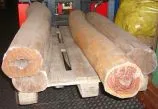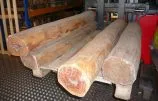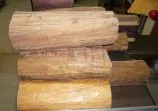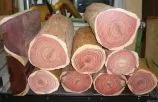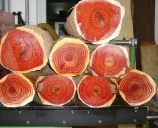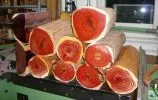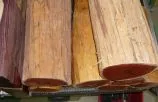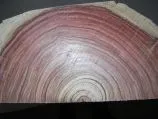Shipping country
Wood Species
Brazilian Tulipwood logs old stock!
03.10.2018
Most of the time we only find unattractive looking things when cleaning up our warehouse-in this case it were 8 inconspicuous looking stems of Brazilian Tulipwood that were felled a long time ago and have been sleeping since then in a high shelf on a pallet. From outside these trunks didn't look great: rather strawy yellow, crooked, with a partly rotten core and lots of cracks they didn't look very exciting. Only a single trunk let see something of the typical red colour on its front surface and let assume of its colour. In the workshop, the first of these trunks turned out to be true treasures after being cut into handier pieces, I haven't seen such a beautiful fine-grained and deep red rosewood in 10 years, nort had something of this quality on the saw table. One can recognize well the special of this true rosewood species Dalbergia decipularis by these small trunks: the trees do not grow very big and old, a trunk diameter of approx. 40 cm including sapwood is already very considerable. Also the height of the trees remains with approx. 6-8 meters rather small for a tree growing only in the northeast of the Brazilian jungle. In addition, these trees usually do not reach a high age, about 50 years they become old, then the death of the tree begins with a core rot beginning from the pith, on these photos you can see this well on two of the trunks still lying on the palette with beginning core rot. The small trees grow like e.g. also snake wood very spread in the jungle, are mostly searched and found by natives and then felled classically with axes, debarked on the spot and freed from sapwood with the axe. In most cases, the traces of this coarse finishing by hand are still visible on the logs, as on these trunks. The Bark as the straw-yellow sapwood will also be hewn away with axes in the jungle, as it is not usable anyway. It unnecessarily increases the weight, as these whole small trunks are carried on the shoulders of indios out of the jungle to the next collection point often over a distance of over tens of kilometres. Sometimes so much can be baled from the existing traces of a trunk... Due to these circumstances the wood of this tree will always remain a rare and expensive speciality, which was is appreciated and highly valued by musical instrument makers and cabinet makers.



